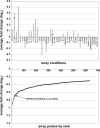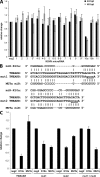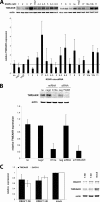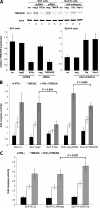Regulation of tumor necrosis factor-like weak inducer of apoptosis receptor protein (TWEAKR) expression by Kaposi's sarcoma-associated herpesvirus microRNA prevents TWEAK-induced apoptosis and inflammatory cytokine expression
- PMID: 20844036
- PMCID: PMC2976403
- DOI: 10.1128/JVI.00884-10
Regulation of tumor necrosis factor-like weak inducer of apoptosis receptor protein (TWEAKR) expression by Kaposi's sarcoma-associated herpesvirus microRNA prevents TWEAK-induced apoptosis and inflammatory cytokine expression
Abstract
Kaposi's sarcoma (KS)-associated herpesvirus (KSHV) is the causative agent of KS, the second most common AIDS-associated malignancy. KSHV expresses at least 18 different mature microRNAs (miRNAs) during latency. To identify cellular targets of KSHV miRNAs, we have analyzed a previously reported series of microarrays examining changes in cellular gene expression in the presence of KSHV miRNAs. Tumor necrosis factor (TNF)-like weak inducer of apoptosis (TWEAK) receptor (TWEAKR) was among the most consistently and robustly downregulated genes in the presence of KSHV miR-K12-10a (miR-K10a). Results from luciferase assays with reporter plasmids containing the 3' untranslated region (UTR) of TWEAKR suggest a targeting of TWEAKR by miR-K10a. The mutation of two predicted miR-K10a recognition sites within the 3' UTR of TWEAKR completely disrupts inhibition by miR-K10a. The expression of TWEAKR was downregulated in cells transfected with miR-K10a as well as during de novo KSHV infection. In a KS tumor-derived endothelial cell line, the downregulation of TWEAKR by miR-K10a resulted in reduced levels of TWEAK-induced caspase activation. In addition, cells transfected with miR-K10a showed less induction of apoptosis by annexin V staining and terminal deoxynucleotidyltransferase-mediated dUTP-biotin nick end labeling (TUNEL) assays. Finally, the downregulation of TWEAKR by miR-K10a in primary human endothelial cells resulted in a decrease in levels of expression of the proinflammatory cytokines interleukin-8 (IL-8) and monocyte chemoattractant protein 1 (MCP-1) in response to TWEAK. These results identify and validate an important cellular target of KSHV miRNAs. Furthermore, we demonstrate that a viral miRNA protects cells from apoptosis and suppresses a proinflammatory response, which may have significant implications in the complex context of KS lesions.
Figures






References
-
- Almstrup, K., C. E. Hoei-Hansen, U. Wirkner, J. Blake, C. Schwager, W. Ansorge, J. E. Nielsen, N. E. Skakkebaek, E. Rajpert-De Meyts, and H. Leffers. 2004. Embryonic stem cell-like features of testicular carcinoma in situ revealed by genome-wide gene expression profiling. Cancer Res. 64:4736-4743. - PubMed
-
- Burkly, L. C., J. S. Michaelson, K. Hahm, A. Jakubowski, and T. S. Zheng. 2007. TWEAKing tissue remodeling by a multifunctional cytokine: role of TWEAK/Fn14 pathway in health and disease. Cytokine 40:1-16. - PubMed
-
- Caselli, E., S. Fiorentini, C. Amici, D. Di Luca, A. Caruso, and M. G. Santoro. 2007. Human herpesvirus 8 acute infection of endothelial cells induces monocyte chemoattractant protein 1-dependent capillary-like structure formation: role of the IKK/NF-kappaB pathway. Blood 109:2718-2726. - PubMed
Publication types
MeSH terms
Substances
Grants and funding
LinkOut - more resources
Full Text Sources
Molecular Biology Databases
Research Materials
Miscellaneous

